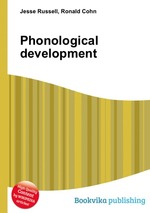Phonological development
Jesse Russell Ronald Cohn
бумажная книга
High Quality Content by WIKIPEDIA articles! Sound is at the beginning of language learning. Children have to learn to distinguish different sounds and to segment the speech stream they are exposed to into units – eventually meaningful units – in order to acquire words and sentences. Here is one reason that speech segmentation is challenging: When you read, there are spaces between the words. No such spaces occur between spoken words. So, if an infant hears the sound sequence “thisisacup,” it has to learn to segment this stream into the distinct units “this”, “is”, “a”, and “cup.” Once the child is able to extract the sequence “cup” from the speech stream it has to assign a meaning to this word. Furthermore, the child has to be able to distinguish the sequence “cup” from “cub” in order to learn that these are two distinct words with different meanings. Finally, the child has to learn to produce these words. The acquisition of native language phonology begins in the womb and isn’t completely adult-like until the teenage years. Perceptual abilities (such as being able to segment “thisisacup” into four individual word units) usually precede production and thus aid the development of speech production.


